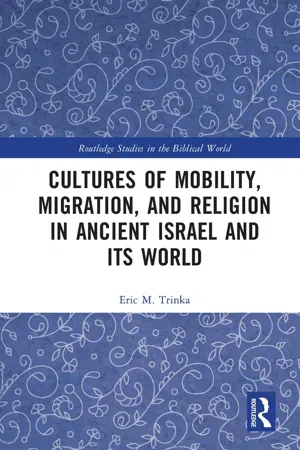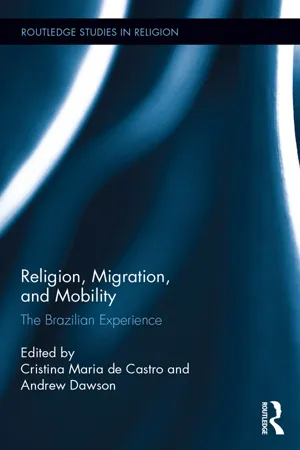Geography
Diffusion of Religion
Diffusion of religion refers to the spread of religious beliefs, practices, and traditions from one place to another. This process can occur through various means such as migration, trade, conquest, and missionary activities. The diffusion of religion has significant impacts on the cultural landscape and can lead to the blending and adaptation of religious practices in different geographical regions.
Written by Perlego with AI-assistance
5 Key excerpts on "Diffusion of Religion"
Learn about this page
Index pages curate the most relevant extracts from our library of academic textbooks. They’ve been created using an in-house natural language model (NLM), each adding context and meaning to key research topics.
- Eric M. Trinka(Author)
- 2022(Publication Date)
- Routledge(Publisher)
Early investigations like those of Montesquieu or Voltaire were driven by a belief that religious practice and belief were instigated and limited by the geographies of praxis. Accordingly, local environmental characteristics were thought to have unquestionably determined the natures of deities, their actions, important calendrical rites, and the imagery of accompanying mythologies. This approach maintained saliency well into the 20th century and is prominent in the work of geographers like Ellen Semple and Ellsworth Huntington. 134 Challenges to this theoretical framework arose from the corners of cultural geography and sociology when Max Weber, and those following his lead, attempted to turn the tables by suggesting that human socio-cultural innovation wields overwhelming formative power over landscape, and thus focused on the means by which humans shape their landscapes in response to their religious beliefs and other cultural activities. In recent decades, the pendulum has returned to a medial position that tempers both of these earlier explanations. This third way follows the lead of geographers, like Lily Kong, who champions a critical geographic perspective from which religions and environments are understood as emergent realities with their own causational capacities. 135 Connections between religion and environment can be appreciated for their reciprocal influences. Religious innovations inform cognitive frameworks and thus change interactions with other physical and social landscapes. As cultural innovation changes environmental contexts, it generates new selective pressures that can influence subsequent culturally innovative and biologically adaptive behaviors. 136 Even though many early comparative forays exploring genetic/biological and cultural evolution treated them as one and the same, important differences are present between the two phenomena- eBook - ePub
The Meanings of Things
Material Culture and Symbolic Expression
- I. Hodder(Author)
- 2013(Publication Date)
- Routledge(Publisher)
The diffusion of religious symbols within complex societiesL. CARLESS HULIN IntroductionThis chapter represents an initial meditation on the processes through which intrusive religious concepts, paraphernalia or practices are absorbed into indigenous religious systems. It has grown out of my research into the non-industrial peasant cultures of the pre-Christian Near East. These cultures are characterized by numerous small agricultural communities standing in a dependent relationship to cities, where power is concentrated in the form of divinely ordained kingships, economically powerful priesthoods and the merchant classes (Sjoberg 1960).During the first half of the 20th century, diffusionism (i.e. the view that most cultural traits emanate from a limited number of sources, and are transmitted by means of contact between peoples) was taken to account for most culture change. When it became clear that this was a somewhat simplistic theory, the entire concept fell into disuse among archaeologists, although geographers and anthropologists continued to refine the concept. Recently, revived interest among archaeologists has concentrated on the more tangible aspects of the process, i.e. the distribution of stylistic traits and technological items (see Davis 1983, for a full bibliography). However, the diffusion of ideas remains an undeveloped concept. The cross-cultural comparison of religious artefacts still tends to be justified on the (diffusionist) basis of degrees of visual similarity, rather than by known patterns of social interaction. Syncretism is used as a model of, rather than a model for, the diffusion of religious symbols.Diffusion and social structureClearly, in general terms, the degree of interaction between communities must determine the amount of diffusion possible (Foster 1962). However, since individuals are the agents of diffusion, and individuals move in socially proscribed circles, the potential for diffusion of any innovation is affected by the relative advantage and mobility of the social circle to which those individuals belong. Although the identification of complex social stratigraphy in the material record in absolute rather than relative terms is notoriously difficult (for example, Cowgill et al - Adam Possamai, Anthony J. Blasi(Authors)
- 2020(Publication Date)
- SAGE Publications Ltd(Publisher)
Roberto Cipriani Roberto Cipriani Cipriani, RobertoDiffused Religion Diffused Religion214 216Diffused Religion
To clarify what diffused religion really means, the term diffused needs to be understood in at least two ways. First, religion is diffused in that it includes vast sections of the population and goes beyond the simple limits of institutional religion. At times, it is actually in open contrast with institutional religion on theological and confessional grounds (e.g., internal dissension within an institutional religion on some occasions with reference to specific issues).Second, religion has become widespread because it has proven to be a historical and cultural result of the long and dominant presence of a religion in a country as well as of its socializing and legitimizing action. Therefore, one can say that the premises of today’s diffused religion have been laid down in the course of centuries, even millennia.Diffused religion concerns a broad strata of population. More than one study has established this over time. However, the most relevant aspect is still the strong historico-geographical—therefore, cultural—rootedness of the religion practiced most in a specific country or group of countries. Strength of tradition, custom, family, and community involvement make membership in a prevalent religion mandatory, compelling, practically unavoidable. Where socialization does not occur within the home, religious activity carried out in a capillary way by ministers, priests, and lay activists takes over. What diffused religion consists of can be understood thanks to its peculiarities. Broadly, its presence is clearly visible in forms that, although not totally invalidated, are not as evident as those of institutional religion. Its visibility may appear somewhat intermittent.- eBook - ePub
Religion, Migration, and Mobility
The Brazilian Experience
- Cristina Maria de Castro, Andrew Dawson, Cristina Maria de Castro, Andrew Dawson(Authors)
- 2017(Publication Date)
- Routledge(Publisher)
IntroductionReligion, migration, and mobility: Setting the scene
Cristina Maria de Castro and Andrew DawsonReligion and migration
In recent decades, the theme of religion and migration has received increasing attention from academics, politicians, and the media. José Casanova, for example, argues that the ‘consequences of the new global patterns of transnational migration’ impacting various parts of the world are ‘substantial’ (2007: 76), while Giuseppe Giordan maintains that the ‘landscape of wide areas of the planet’ is being ‘radically transformed … by a transnational migration process’ in which ‘the number of migrants in the world has grown in the last 50 years from 80 million to 214 million’ (2014: 7–8). Consequently, and although ‘95 per cent of the people of the world are not migrants,’ as Wimmer and Schiller assert (2002: 326), the scale and rapidity of modern-day transnational migration engenders a range of challenges impacting increasing numbers of the global population, irrespective of their sedentary or mobile status. With increased globalization, the mobility of people, beliefs, and cultures has become progressively visible and is having a growing impact on host societies. In addition to the hope of better lives for themselves and their families, immigrants carry with them sets of beliefs and religious practices that are, sooner or later, mobilized in the post-migratory context of the new host society. As inspiration for narratives and practical action, the religions of migrants must survive and meet the pressures and challenges of their new environments, be they political, cultural, social, or material. The difficulties imposed by the post-migratory challenges of religious reterritorialization vary according to a range of practical and symbolic variables, and, as the following chapters of this book demonstrate, the religions of immigrants not only meet and overcome these difficulties but also contribute to the formation of a richer and more plural local religious field. - eBook - ePub
Religions in the Modern World
Traditions and Transformations
- Linda Woodhead, Christopher Partridge, Hiroko Kawanami, Linda Woodhead, Christopher Partridge, Hiroko Kawanami(Authors)
- 2016(Publication Date)
- Routledge(Publisher)
- ■ Emerging immigration flows are described as having ‘super-diversity’, with highly variegated social formations, particularly in global cities. Super-diversity has had a profound effect in the religious field in societies of settlement.
- ■ Transnationalism entails a strategic presentism, a multiple embeddedness in social fields in the now, as the transmigrant seeks to adjust creatively to the rapidly changing demands of flexible production in late capitalism. Diaspora, in contrast, retrieves or invents a common origin and tradition and commemorates idealized geographic spaces and objects as a way to dwell in an inhospitable present and perhaps bring about a ‘return to the future’.
- ■ The interplay of globalization, migration, and religion has been dramatically intensified by rapid innovations in computer-mediated communications (CMCs), particularly expansion of the internet and the rise of social media.
Key terms
center-periphery model A spatial model that analyzed trade and power relations between countries at the core of capitalist production and accumulation (traditionally countries in Europe and North America) and those who occupy a dependent, secondary or even marginal place.deterritorialization and reterritorialization Refers to the spatial dimensions of social dissembedding: the erasure and redrawing of our ways of understanding social space and belonging produced by rapid social change, particularly globalization.diaspora Traditionally, the forcible dislocation of a people from their homeland, such as the Jewish diaspora following the conquest of the Kingdom of Judah by the Babylonians in the sixth century BCE . With contemporary globalization, the term has been increasingly applied to migrant groups in societies of settlement.episcopal Related to the office of the bishop, whose exercises his authority over a territory often termed diocese. A particular country may have several dioceses, leading to the formation of national episcopal bodies.global religious orders




